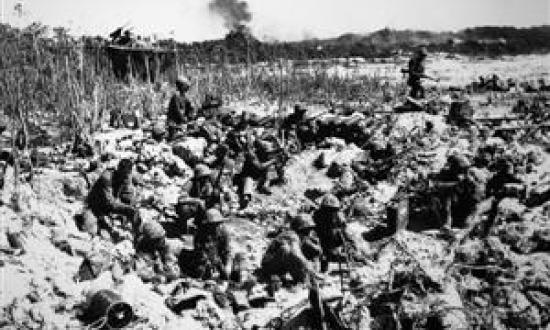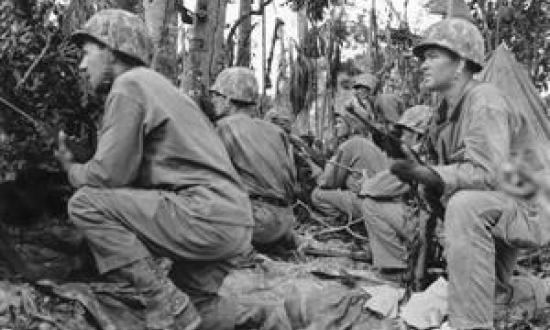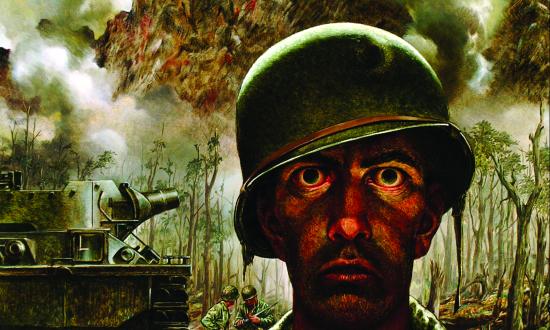Landing on Peleliu in September 1944, the 1st Marine Division faced fierce resistance. Its 1st Marine Regiment sustained 54 percent casualties during the campaign, and the 5th and 7th sustained 43 percent and 46 percent, respectively.2 Overall, the division and attached units suffered 7,790 casualties: 1,259 dead, 43 missing, and 6,488 wounded.3 1st Marine Division became combat ineffective and was not used again for an amphibious landing until April 1945 on Okinawa.
The intense combat came as a surprise to the leaders of the landing forces and initially overwhelmed the medical resources. Military medical care—which includes protection of casualties, evacuation, and treatment—is difficult to perform during combat, and the Peleliu landing was no different, even with improvements over former campaigns. A previously unpublished manuscript about the Carolines operations, as well as the personal correspondence of the division surgeon, have shed new light on what lessons were learned and what recommendations were made, many of which are still important today.1
Medical Operations Casualty Care
Marines wounded on Peleliu were simultaneously treated and evacuated as combat conditions permitted. Normally, medical companies would set up on shore as soon as possible after a landing, but during the first few days on Peleliu, the fighting was so intense that the wounded were collected and initially treated at beach evacuation centers by medical personnel sent ashore from the transports.4 The earliest medical company did not make it on shore until five days after the initial landing, and by ten days in, 3,756 of the eventual 5,554 casualties had been evacuated.5 Medical company personnel were used in limited fashion to augment the medics from the combat team and to collect casualties.
Because outcomes for the severely wounded often depend on the length of time from injury to surgery, prompt evacuation to a surgical team is imperative. At Peleliu, care on the beach was primarily first aid to prepare patients for transport offshore by amphibious vehicles—which delivered both Marines and supplies to the island—on their return trips to the ships.6 The wounded were collected on the beach by the shore medical evacuation centers and brought to the coral reefs by either amphibious tractors or DUKWs (an amphibious all-wheel-drive truck). At the coral reefs, a landing ship tank (LST) or other landing craft would receive wounded Marines then transfer them to transports with medical capability.
Three types of ships received patients: attack transports (APAs), hospital ships (AHs), and LSTs, some of which had limited surgical capability.7 During the Peleliu landings, when the LST was met at the reef’s edge, a further triage could be conducted by the “Reef Beach Medical Section.”8 Patients could be moved to APAs or treated on the LST. Certain APAs were designated to receive and provide surgical care to patients. The after-action report of the USS Fayette (APA-43) noted that a total of 302 wounded were brought on board from Peleliu, 70 percent of whom had sustained gunshot wounds.9 The majority of casualties had wounds to the upper (33 percent) or lower (37 percent) extremities.10
The AHs were equipped with surgical teams and, in general, had more experienced surgeons and could provide higher quality care. Unfortunately, the four assigned AHs—the USS Samaritan (AH-10), Bountiful (AH-9), Solace (AH-2), and Relief (AH-1)—did not arrive until at least one to two days after the initial landings (two, four, five, and seven days post landing, respectively), and so were not present for the first three days of intense fighting, when specialty care was needed. The first to arrive, the Samaritan, was quickly loaded with 607 patients who had already had their initial surgery on one of the APs or LSTs.11 She then sailed several hours to base hospitals farther from the fighting.
Division Surgeon
Captain Joseph Logue, the division surgeon from June 1943 to December 1944, was an experienced military medical officer and provided medical leadership during the Cape Gloucester and Peleliu campaigns. He graduated from the Medical College of Georgia in 1918, followed by a commission in the U.S. Navy and an internship at Charleston Naval Hospital. Because of wartime exigencies, he became a ship’s physician on the USS Madawaska (ID-3011) bringing back troops from overseas after World War I. He served as a medical officer in the Dominican Republic (with U.S. Marines) in 1922–23, returning as part of the Haiti Public Health Service, still in U.S. naval service and working with Marines, from 1927 to 1930. In between, he obtained postgraduate education at Columbia University and Massachusetts General Hospital to become an orthopedic surgeon. He subsequently served on a hospital ship and a repair ship, the Relief and the USS Medusa (AR-1). His experiences with the Marines and as a surgeon made him a prime candidate to be division surgeon.
Preventive Medicine
During the Cape Gloucester campaign, Marine losses from infectious disease outnumbered those from battle casualties. Logue implemented changes to reduce the spread of disease by insects and rodents by clearing living areas of brush or cover, spraying with insecticide, and using personal repellant.12 He documented the effectiveness of these measures in an article entitled “Scrub Typhus” published in the U.S. Naval Medical Bulletin.
Expecting similar issues on Peleliu, Logue took advantage of a new insecticide that was available in quantity—dichloro-diphenyl-trichloroethane (DDT). Three “sanitary squads” of 15 Marines each were organized, one for each of the assaulting regiments. Modified paint sprayers were mounted on the back of a 1-ton truck to spray the DDT directly from 55-gallon drums. Spraying dead bodies, rubbish piles, trenches, and any standing water behind the assaulting regiments was the first priority to prevent disease spread from flies, mosquitoes, and other insects.13
Psychiatry
The intense fighting on Peleliu also created conditions for “combat stress reaction” (CSR), when Marines suffered from intense heat, lack of sleep, lack of water, and an irregular diet. These intense physical and mental demands can lead to fatigue, slower reaction times, inability to prioritize, indecision, and disconnection from one’s surroundings. Tom Lea, a military artist for Life magazine and other publications, documented the look associated with CSR in his famous drawings and the painting entitled “The 2,000-yard Stare” while on Peleliu.14
Recognition of CSR symptoms and prompt treatment with safety, rest, and food were not necessarily possible on Peleliu. Because of the prevalence of symptoms among soldiers and Marines who had been in sustained combat, a psychiatrist was recommended for every combat division, initially with the U.S. Army, to help care for the men without removing them from the division. Evacuating soldiers and Marines resulted in a loss of time and combat manpower, as well as the potential for creating a permanent “casualty” with a psychiatric diagnosis, when in fact the service member was demonstrating a normal response to combat over time.
Commander Injury and Conflict of Interest?
The 1st Marine Division commander, Major General William H. Rupertus, was injured when he fell from an amphibious tractor during a training exercise, fracturing his ankle.15 This meant he would be in a cast during the Peleliu landings. Not wanting to relinquish his command, however, Rupertus avoided reporting his status to his immediate superior. Nevertheless, the Commandant of the Marine Corps, General Alexander Vandegrift, became aware of the situation after visiting the staging area on Pavuvu, and he felt Rupertus could still be commander for the operation. Brigadier General Oliver P. Smith asked Captain Logue whether Rupertus could undertake the landing, and Logue was reported to have thought so, but said Rupertus would require a cane. Since Logue worked directly for Rupertus, this was an awkward situation. In truth, a medical evaluation at the Corps or higher level would have been more appropriate.
(Courtesy of the Authors)
Lessons Learned
Soon after Peleliu was secured and the 1st Marine Division left, Logue reported his and others’ observations regarding the medical support provided on Peleliu to the U.S. Navy’s Surgeon General, Admiral Ross T. McIntire. Because of rapidly moving events, Logue sent a personal letter directly to Admiral McIntire, in hopes the lessons could be applied sooner than might have happened had a memo gone through official channels.16
He recommended that the complement of corpsman be augmented by from 32 to 40 per battalion when engaged in combat operations. In addition, he felt the assignment of 32 men per battalion as stretcher bearers helped with evacuation and improved morale, as well as allowing for a ready pool to evacuate Marines from the battlefield. Logue also recommended supplying prefabricated splints to prepare patients with injured limbs for transport.
For surgical care, Logue felt the division should have an attached “roving” surgical team consisting of specialists in general, orthopedic, trauma, neurosurgery, and ophthalmology, with enough operating room equipment for several cases. The team should be attached to divisions engaged in combat and not be part of the organic complement. He recommended small prefabricated operating rooms with blacked-out windows to support the surgical mission. (The prefabricated operating room came later in the campaign.) He also recommended the team have an attached psychiatrist.
He felt organic medical assets should include preventive medicine and sanitation, since those services were needed all the time in divisions living under field circumstances. Logue noted that the training for field sanitation and hygiene among the medical officers generally was lacking and there seemed limited professional interest in these areas.
Logue wrote that hospital ships should be present soon after landings occur, fulfilling their mission of being a floating hospital to care for wounded soldiers and Marines. The lack of specialty surgical care from the AHs at Peleliu meant that the first few days of casualties were treated on the other ships, and skilled surgeons were not necessarily present.
Lessons Learned
What lessons does medical care at Peleliu teach for the 21st century? First, uncertainty about the course of an operation always exists. The 1st Marine Division was not expecting the number or severity of casualties that occurred, necessitating innovations in triage both on shore and at the reef edge.
Second, surgical care should be provided as soon as possible. Mobile surgical teams were used by the Army with success prior to Peleliu and were collocated with a collecting company to provide surgery on the severely wounded, particularly those who could not be further transported without deleterious effects. Marine medical companies could not be set up on Peleliu prior to set up on Peleliu five days after the initial landings because of the intensity of combat, and thus early surgery could not be done on shore before then. While first aid, with some fluid resuscitation, could be provided, initial surgery could only be conducted on the LSTs or APs offshore. Quick evacuation was necessary to get the best results for the severely wounded. More recent conflicts have not been characterized by such a high volume of casualties over a very short period. There were occasions in Afghanistan in which evacuation time for wounded personnel was considered excessive. Efforts were made to improve aeromedical assets to get wounded to needed care in a more suitable time.
Learning about and implementing preventive medicine and sanitation practices was unpopular among physicians at Peleliu and during other campaigns. In both war and peace, preventing disease is an important task for public health and preventive medicine organizations. Recent natural disasters such as the fires in California and hurricanes in the southeast United States have created temporary public health crises arising from a lack of potable water, housing, sanitation, and physical safety. Public health and preventative medicine education should be a universal requirement for all graduates of medical school.
Finally, corpsman and doctors treating patients under combat conditions also face being wounded or killed. Casualties for the 1st Marine Division were one doctor killed and five wounded, with 39 corpsmen killed in action, 12 more dying of wounds, and 145 wounded in action. Corpsman assigned to combat units face the greatest risk, and the decision on Peleliu to augment the number of corpsmen assigned to each infantry battalion was helpful in continuing front line care.
1. Anonymous, “The Carolines,” chapter 9 in U.S. Navy Medical Department, Administrative History 1941–45, unpublished manuscript; Joseph B. Logue to Admiral Ross T. McIntire, Surgeon General U.S. Navy, 7 November 1944, JB Logue papers, held by the authors.
2. Anonymous, “The Carolines”; Joseph B. Logue to Admiral Ross T. McIntire; and Gail B. Shisler, For Country and Corps: The Life of General Oliver P Smith (Annapolis, MD: Naval Institute Press), 74–76.
3. Joseph B. Logue. Letter to Admiral Ross T. McIntire.
4. Anonymous, “The Carolines”; Joseph B. Logue to Admiral Ross T. McIntire.
5. Anonymous, “The Carolines.”
6. Anonymous, “The Carolines”; Joseph B. Logue to Admiral Ross T. McIntire.
7. Anonymous, “The Carolines.”
8. Anonymous, “The Carolines”; U.S. Army, After Action Report: USS Fayette (APA-43), 1944.
9. United States Army, After Action Report: USS Fayette.
10. United States Army, After Action Report: USS Fayette.
11. Anonymous, “The Carolines.”
12. Joseph B. Logue, “Scrub Typhus,” U.S. Naval Medical Bulletin 43 (1945): 645–49.
13. Joseph B. Logue and Hugh V. O’Connell, “DDT: Practicality of Use During Invasion,” U.S. Naval Medical Bulletin 44 (April 1945): 877–82.
14. Tom Lea, The Two Thousand Yard Stare: Tom Lea’s World War II, ed. Brendan Greeley (College Station, TX: Texas A&M Press, 2008), 173–96.
15. Gail B. Shisler, For Country and Corps: The Life of General Oliver P. Smith (Annapolis, MD: Naval Institute Press, 2009), 74–76.
16. Joseph B. Logue to Admiral Ross T. McIntire.









